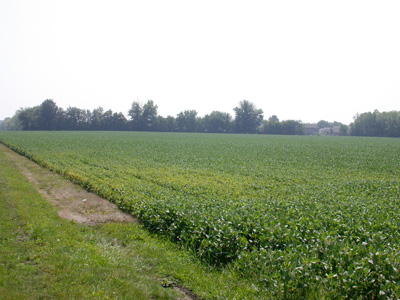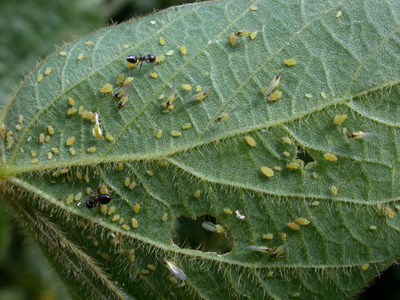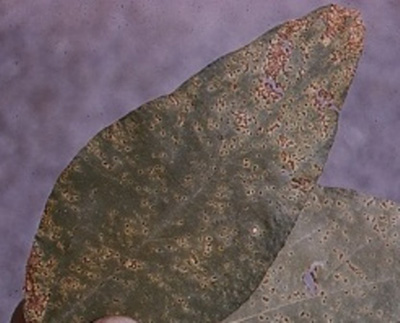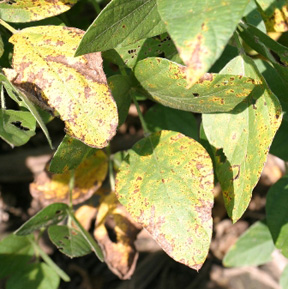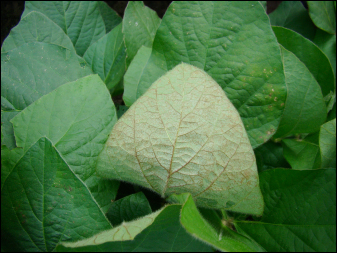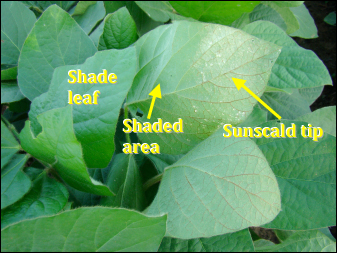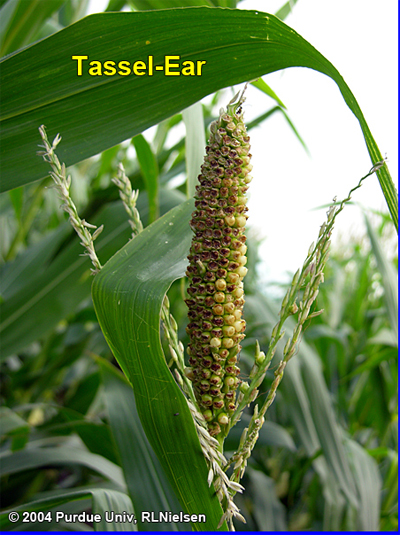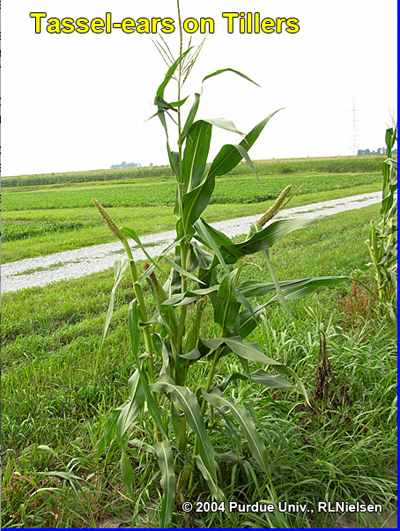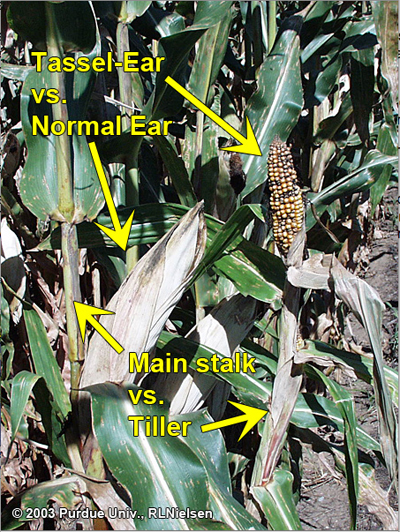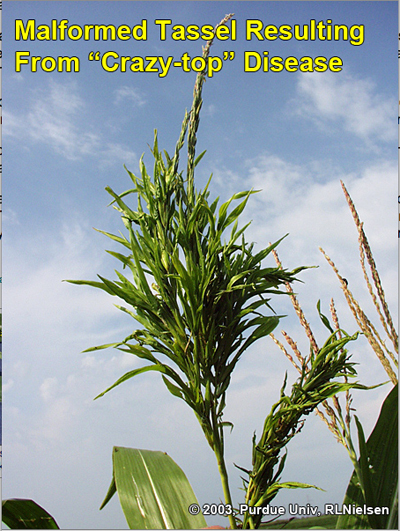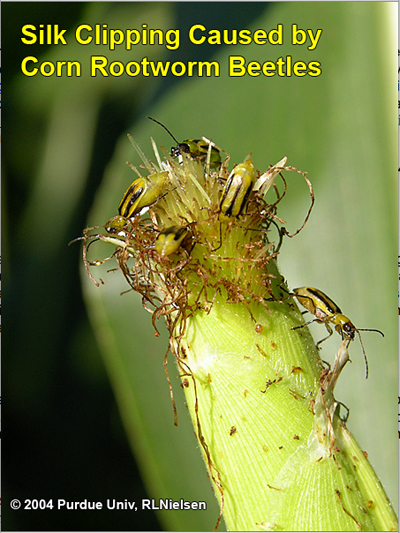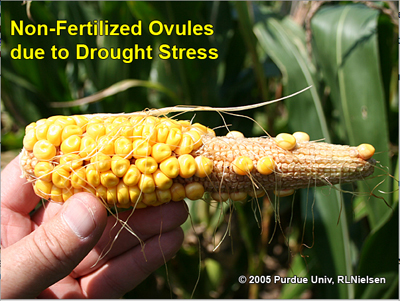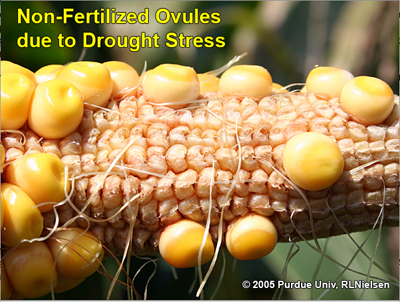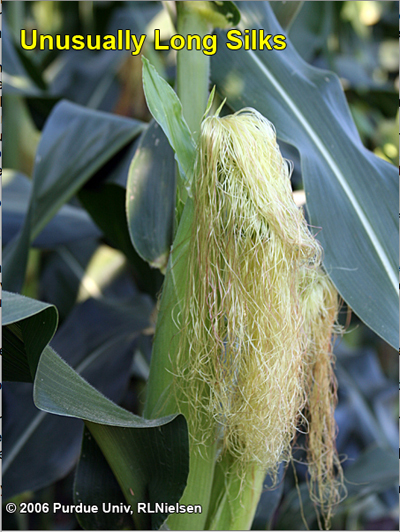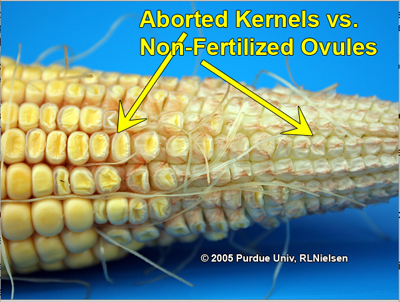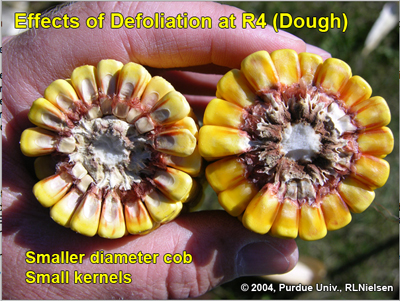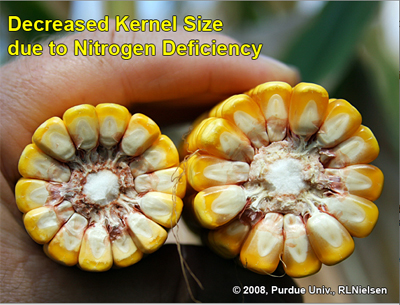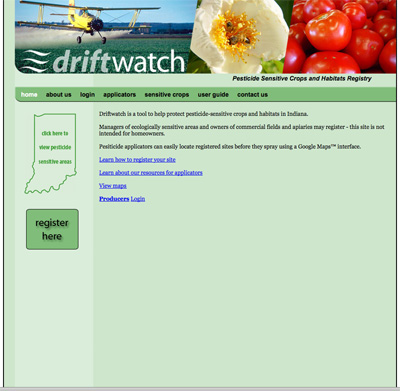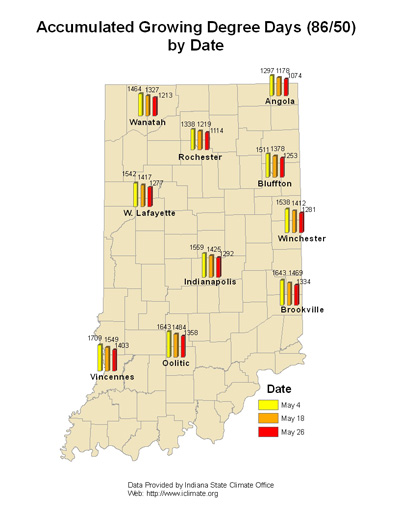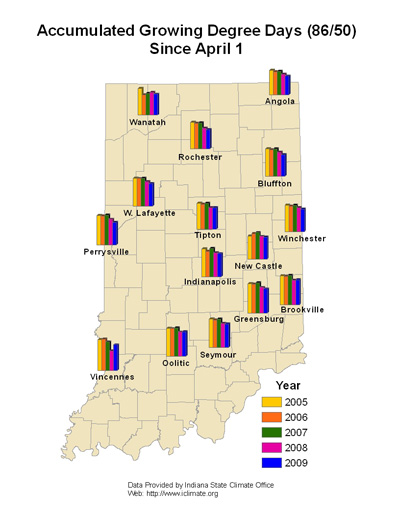Pest & Crop Newsletter, Entomology Extension, Purdue University
- Yellow Beans, Many Causes
- Soybean Aphids: Over Threshold in Northwestern Indiana
- Black Light Trap Catch Report
Yellow Beans, Many Causes - (Christian Krupke and John Obermeyer)
- Many factors, some in combination, cause soybean plants to discolor.
- Scout to determine that spider mites are not the primary cause for yellowing.
While driving through different areas of the state it is amazing to see the number of soybean fields exhibiting areas of yellow.
A number of factors can cause leaf yellowing. These include, but not limited to, soybean cyst nematode, nutrient deficiencies, poor nodulation, herbicide injury, diseases, compaction, etc. Spider mites may be present along with any of these other plant stressors and may or may not be causing the discolored foliage. In other words, it’s the old chicken and egg dilemma. Stressed plants actually provide a better nutritional feast for spider mites thus they thrive and quickly colonize areas or whole fields. The best spider mite control is to eliminate plant stress, and in the absence of timely rains, this is often easier said than done.
Before considering control, it is very important that spider mites be conclusively identified as the source of the problem. Shake some discolored soybean leaves over a white piece of paper. Watch for small dark specks moving about on the paper. Also look for very fine webbing on the undersides of the discolored leaves. Once spider mites have been positively identified in the damaged areas of the field, it is essential that the whole field be scouted to determine the range of infestation. Sample in at least five different areas of the field and determine whether the spider mites are present or not by using the “shake” method. Happy scouting!
High tech tools for rootworm sampling
Click on the above link to watch this riveting short video on spider mite scouting and proper identification
![]()
Soybean Aphids: Over Threshold in Northwestern Indiana - (Christian Krupke)
- First fields over 250 aphids/plant threshold reported in LaPorte Co.
- Winged apids also spotted, indicating that migrations may occur soon.
Although it looked like we might avoid it this year, we have confirmed reports of soybean aphids at levels over the treatment threshold of 250 aphids/plant in the state. These reports originate in LaPorte county, and with several other fields in the area in the high double-digits this week, it is likely there are more to come.
As we stated in earlier Pest&Crop issues, aphids have been relatively scarce in the Midwest this year. However, last week we found our first aphids in sentinel plots in Indiana and this week brought some higher populations. It appears that we may see a late push from aphids. However, time is on our side – once fields hit R6, aphids are not a concern and with most Indiana fields well into R3/R4, we are not too far off.
We did find winged aphids in the infested fields, but they were relatively few and far between – this is a good sign, as a high proportion of winged aphids are an indication that those aphids will soon leave and become a problem for someone else. Beneficial insects, mostly ladybugs, were also quite abundant which is another good sign. Large populations of ants will often be found in conjunction with soybean aphid infestations. These ants are harvesting the sugary honeydew from aphids and will sometimes actually protect aphids from predators.
All in all, this news should be viewed as a reminder that we are not out of the woods yet, and producers in the northern third of the state (particularly the northwestern corner), should still be scouting. As was the case last week, the vast majority of Indiana soybean fields do not have a single aphid in them at this point. However, among those that do there are certainly some that require treatment. Don’t let your fields be among those that are not scouted until they are over threshold – take the time for a quick survey of 20 plants throughout the field – with winged aphids on the move, fields can become infested very rapidly.
Several winged soybean aphids on a soybean leaf, surrounded by other aphids of various stages, all being tended by ants
![]()
Click here to view the Black Light Trap Catch Report
Bacterial Blight of Soybean – (Kiersten Wise)
Scouting reports and sentinel plot samples across Indiana confirm that bacterial blight of soybean is present at low levels in many fields. This disease is rarely yield-limiting in Indiana, but it can easily be confused with brown spot of soybean and accurate diagnosis is important for effective management.
Bacterial blight is characterized by small water-soaked lesions that are yellow to brown and often are surrounded by a yellow halo (Figure 1). These lesions can expand and forming areas of dead leaf tissue that may disintegrate causing the leaf to have a tattered appearance. Lesions caused by bacterial blight are typically found on the younger leaves of the plant, in the upper canopy. The disease is spread by rain and wind, and favored by cooler weather (70-80°F).
Figure 1. Bacterial blight on soybean leaves (Picture Courtesy: G. Shaner)
Brown spot also produces yellow to brown lesions, however, they are typically found in the lower canopy on older leaves. Lesions of brown spot will also lack the yellow halo present in young lesions of bacterial blight (Figure 2).
Figure 2. Brown spot on soybean leaves
Bacterial blight can be managed through crop rotation. Take note of infected fields and choose varieties that are less susceptible to bacterial blight when next planting beans in those areas. Applications of strobilurin or strobilurin/triazole fungicides (Headline, Quadris, Quilt, Stratego, others) are not recommended for management of bacterial blight.
![]()
Sunscald of Soybean During Coolest July in History? – (Shaun Casteel, Purdue Soybean Specialist)
The month of July felt more like fall than summer with the coolest temperatures in recorded history of Indiana. Night temperatures ranged from the mid 50s to low 60s the week after the 4th of July. The following two weeks were as low as the upper 40s in many areas of Indiana to mid 50s in other areas. Daily high temperatures were in the low to mid 80s over the past three weeks. Additionally, the humidity was quite low on most days of July.
Sunscald is often associated with intense sunlight and low humidity following warm temperatures and high humidity. Temperatures that were below normal combined with low humidity do not sound like a recipe for sunscald. However, the temperature swing of approximately 30 degrees between the night and the day produced heavy dews in our soybean fields. Some areas also experienced bright sunny days that provided enough UV radiation, regardless of the daily high temperature, to “burn” the soybean leaves that were saturated by these heavy dews.
The “burning” due to sunscald usually appears on the underside of the soybean leaves and can progress from a silvery color to a bronzy color (Fig. 1). These symptoms often show up on the tip of the leaves in the upper canopy. Neighboring leaves can “protect” other leaves from sunscald by shading it (Fig. 2). The bronzing to purpling of the soybean leaves should not be confused with Cercospora leaf blight that can develop irregular purple lesions during seed set. Sunscald of soybean is usually scattered and sporadic in a field and should not influence yield.
Figure 1. Silvery to bronzy soybean leaf tip due to sunscald in the upper canopy.
Figure 2. Sun-scalded soybean leaf partially protected by neighboring leaf.
![]()
A Tale of Three Cropping Seasons - (Bob Nielsen)
The summer of 2009 in Indiana will likely go down on record as one of the coolest cropping seasons in recent history. July went into the record books as the second coolest July since 1871 (WISH-TV, 1 Aug 2009). Coupled with the significant delay in planting progress, the current slow pace of crop development has generated a lot of coffeeshop talk about what impact there will be on corn grain yield and whether there is a significant risk of some of the crop not maturing safely before a killing fall frost.
History is often not a reliable predictor of the future, but looking at similar instances of slow crop progress in the past can sometimes offer a glimpse of the future possibilities. There are three such similar instances of slow crop progress in Indiana beginning with 1992.
Silking progress that year, again in 2002, and again in 2008 occurred at similar late calendar periods (Fig. 1). Compared to the current 5-year average pace, silking progress in all three of those cropping seasons was about two weeks behind average. As the crop moved through the remainder of the grain filling period, crop progress all three years continued to lag behind the 5-year average; though the 2002 season matured slightly ahead of the 1992 and 2008 seasons (Fig. 2). Crop maturity for those three years occurred one to two weeks behind average.
Figure 1. Corn silking progress in Indiana for select years.
Figure 2. Corn maturity progress in Indiana for select years.
Figure 3. Corn grain yield relative to historical trend line for Indiana in 1992, 2002, and 2008.
So, what is the point of all this? Simply put, the current 2009 silking progress for corn in Indiana is nearly identical with that exhibited by the 1992, 2002, and 2008 crops (Fig. 1). If this calendar lag continues, the 2009 corn crop will also likely mature at least two weeks behind the 5-year average (Fig. 2). Maybe the eventual grain yields recorded for those years can provide us with a hint of the future to come?
Or, maybe not.
The statewide average corn grain yield in 1992 for Indiana was 16.4% above the historical trend; the largest positive departure from trend since 1942. Conversely, the statewide average corn grain yield in 2002 for Indiana was 15.3% below the historical trend; the largest negative departure from trend since the drought of 1991. Finally, statewide average corn grain yield for Indiana last year (2008) was slightly (4.8%) above the historical trend yield.
So, what are we to make of three cropping seasons whose crop progress was so similarly delayed, yet which eventually ended with statewide grain yields so dramatically different? As I often like to remind folks, there are a gozillion factors that influence grain yield in corn. Ultimately, grain yield represents the complete integration of effects from every yield influencing factor that occurs throughout a particular cropping season. Delayed crop progress is but one of many such yield influencing factors.
The slow cropping season of 1992 was indeed a cool summer; best remembered by those of us “long in the tooth” for the unusually late killing freezes of June 21 and 22 that devastated crops throughout northern and westcentral Indiana. The remainder of the summer was also cool with August ending up as the 5th coolest August since 1900. Rainfall was not lacking and, if anything, was a bit excessive throughout much of the summer. AND YET.... the corn crop responded with yields that far exceeded anyone’s imagination. Lack of heat and drought stress on a late crop was a real advantage that year.
By contrast, the 2002 crop got off to a slow start with very delayed planting statewide. However, rather than a cool summer, the 2002 cropping season was characterized by very hot and dry conditions from late June through at least mid-August. The warm temperatures helped the crop make up for some of the delayed planting, but still matured about one week behind the 5-year average. One of the key yield influencing factors in 2002 was the combination of delayed crop development (especially silking and early grain fill) and hot, dry stressful conditions in late July and early August. Knock on wood, but Indiana corn fields have escaped that damaging combination in 2009 to date.
The 2008 crop was similarly delayed in its progress throughout the year but experienced more of a “mixed bag” of weather, ranging from enough moisture and moderate temperatures to too little moisture and hot temperatures. The “mixed bag” of weather conditions played a role in that late-developing crop achieving slightly above average yields (4.8% above trend).
Bottom Line
The current corn crop is moving out of the important pollination period and into the equally important grain filling phase. It is true that this year’s late corn planting and uneven stand establishment are not favorable for optimum yields, but it is also true that most of the state’s crop has, so far, escaped serious stress from drought, heat, disease, and insects.
Moderate temperatures and adequate moisture during the grain fill period are favorable for kernel set success and kernel weight development. For what it is worth, the percentage of the 2009 Indiana corn crop rated by USDA-NASS as good to excellent has consistently been in the low 60’s since early June (only slightly below those of the 2008 crop). Based purely on the historical relationship between July crop condition ratings and statewide grain yield, such ratings would predict trend line yield (aka average yield) for Indiana’s corn crop this year.
The remainder of this season will greatly determine eventual yields of this year’s corn crop. Two major hurdles remain for this year’s crop. One is to avoid serious heat/drought stress for the remainder of August and the early part of September. The other is to avoid an early killing fall frost in late-planted fields not yet physiologically mature (kernel black layer), but it is too early to predict the probability of that risk.
As the old saying goes....”The opera ain’t over until the fat lady sings.”
References
Nielsen, RL (Bob) 2009. Cool Temperatures: Good News or Bad News for Corn? Corny News Network, Purdue Univ. [online] <http://www.kingcorn.org/news/articles.09/GoodNewsBadNews-0721.html> [URL accessed 8/3/09].
Nielsen, RL (Bob). 2009. Corn Planting Date is Important, But.... Corny News Network, Purdue Univ. [online] <http://www.kingcorn.org/news/timeless/PltDateCornYld.html> [URL accessed 8/3/09].
USDA-NASS. 2009. Crop Progress. USDA National Ag. Statistics Service. [online] <http://usda.mannlib.cornell.edu/MannUsda/viewDocumentInfo.do?documentID=1048> [URL accessed 8/3/09].
USDA-NASS Indiana. Indiana Reports and Statistics. USDA National Ag. Statistics Service. [online] <http://www.nass.usda.gov/Statistics_by_State/Indiana/index.asp> [URL accessed 8/3/09].
![]()
Tassel-Ears in Corn - (Bob Nielsen)
Seems like every year about this time someone walks into the Chat ‘n Chew Cafe carrying an odd-looking tassel that is part tassel and part ear to show off to the guys over at the corner table.Much discussion always ensues over the causes of tassel-ears, but the usual consensus is that it falls into the general category of corny oddities and is rarely a yield-influencing factor.
A corn plant exhibits both male flowers and female flowers (a flowering habit called “monoecious” for you trivia fans.) Interestingly, both flowers are initially bisexual (aka “perfect”), but during the course of development the female components (gynoecia) of the male flowers and the male components (stamens) of the female flowers abort, resulting in tassel (male) and ear (female) development.
Once in a while, the upper flower that typically becomes a tassel instead forms a combination of male and female floral parts on the same reproductive structure. The physiological basis for the survival of the female floral parts on the tassel is likely hormonal, but the environmental “trigger” that alters the hormonal balance is not known.
Tassel-ear with both male and female floral parts
Tassel-ear from tiller, with dried silks still visible.
This “tassel-ear” is an odd-looking affair and is found most commonly on tillers or “suckers” of a corn plant along the edges of a field or in otherwise thinly populated areas of a field. It is very uncommon to find tassel-ears that develop on the main stalk of a corn plant.
Tassell-ears on tillers.
Tassel-ear from tiller, with dried silks still visible.
Mass of leafy tissue in a tassel of plant infected with "Crazy top" disease.
Without a protective husk covering, the kernels that develop on tassel-ears are at the mercy of weathering and exposed to hungry birds. Consequently, harvestable good quality grain from tassel-ears is a rarity.
Some folks lump the tassel-ear symptom into the same category as the malformed tassel symptom of the so-called “crazy top” disease. These two odd tassel symptoms are not related and, in fact, look totally different. The “crazy top” disease is caused by infection of young corn plants during ponding events by the soil-borne fungus Sclerophthora macrospora that eventually expresses itself by altering normal tassel development (and sometimes ear shoot development) into a mass of leaf tissue.
Related References
Lipps, Pat and Dennis Mills. 2001. Crazy Top of Corn. Ohio State Univ. Extension publication AC-0034-01. [online] <http://ohioline.osu.edu/ac-fact/0034.html> [URL accessed 8/3/09].
Nielsen, R.L. (Bob). 2003. Tillers or “Suckers” in Corn: Good or Bad? Corny News Network, Purdue Univ. [online] <http://www.kingcorn.org/news/articles.03/Tillers-0623.html> [URL accessed 8/3/09].
Thomison, Peter. 1995. Corn Growth and Development - Does Tillering Affect Hybrid Performance? Ohio State University Extension publication AGF-121-95 [online] <http://ohioline.osu.edu/agf-fact/0121.html> [URL accessed 8/3/09].
![]()
Effects of Stress During Grain Filling in Corn - (Bob Nielsen)
Field potential in corn is influenced at several stages of growth and development. Ear size potential (number of potential kernels) is determined quite early, from about knee-high to about shoulder-high, or from about leaf stage V6 to V15. The next influential period for the corn crop is pollination. The period following successful pollination and finishing at kernel black layer is defined as the grain filling period in corn and represents the final important yield determining time frame. Grain fill stages in corn are described in an accompanying article. Perfect conditions for ear size determination and pollinations can still be negated if severe stress occurs during the grain fill period.
Yield loss during grain fill can occur from 1) stand loss, 2) incomplete kernel set, 3) decreased kernel weight, and 4) premature plant death.
Stand Loss During Grain Fill
Yield loss due to stand loss during grain fill is usually greater than that due to stand loss that occurs during the vegetative phase. When stand loss occurs prior to pollination, ear size (number of kernels) on surviving plants may compensate in response to the lesser competition of a thinner stand. Additional compensation may occur during grain fill in terms of greater kernel weight. When stand loss occurs during grain fill, ear size has already been set. Only kernel weight can compensate in response to the lesser competition of a thinner stand.
Incomplete Kernel Set in Corn
Kernel set refers to the degree to which kernels have developed up and down the cob. Incomplete kernel set is not always apparent from “windshield” surveys of a corn field. Husks and cob will continue to lengthen even if kernel set is incomplete. A wonderfully long, robust-looking, healthy green ear shoot can completely mask even a 100 percent failure of pollination or severe kernel abortion.
TECHNICAL TRIVIA:
Pollination is the movement of pollen from the tassels to the silks.
Fertilization is the actual union of the male and female gametes once the pollen tube reaches the ovule.
One of the causes of incomplete kernel set is unsuccessful fertilization of the ovules during pollination. Unsuccessful fertilization results in ovules that never develop into kernels and, subsequently, ears with varying degrees and patterns of incomplete kernel set. Many factors can cause incomplete pollination and distinguishing between them can be very difficult.
• Certain insects like corn rootworm beetles and Japanese beetles can interfere with pollination and fertilization by their silk clipping action. These insects feed on pollen and subsequently clip silks as they feed on the pollen that has been captured by the silks. Unusually early or late pollinating fields are often particularly attractive to these insects.
• Drought stress may delay silk emergence until pollen shed is nearly or completely finished. During periods of high temperatures, low relative humidities, and inadequate soil moisture levels, exposed silks may also dessicate and become non-receptive to pollen germination.
• Unusually favorable conditions prior to pollination that favor ear size determination can result in ears with an unusually high number of potential kernels per row. Remember that silk elongation begins near the butt of the ear and progresses up toward the tip. The tip silks are typically the last to emerge from the husk leaves. If ears are unusually long (many kernels per row), the final silks from the tip of the ear may emerge after all the pollen has been shed.
• Occasionally, silk emergence begins to occur several days prior to the anthers beginning to shed pollen. Although silks remain viable to pollen germination for up to 10 days after emergence, they begin to slowly deteriorate (age, desiccation) after 4 to 5 days. It is conceivable that kernel set near the butt or base of the cob may fail under these conditions.
Another cause of incomplete kernel set is abortion of fertilized ovules. Aborted kernels are distinguished from unfertilized ovules in that aborted kernels had actually begun development. Aborted kernels will be shrunken, mostly white, often with the yellow embryo visible; compared to normal plump yellow kernels.
Kernels are most susceptible to abortion during the first 2 weeks following pollination, particularly kernels near the tip of the ear. Tip kernels are generally last to be fertilized, less vigorous than the rest, and are most susceptible to abortion. Once kernels have reached the dough stage of development, further yield losses will occur mainly from reductions in kernel dry weight accumulation.
• Severe drought stress that continues into the early stages of kernel development (blister and milk stages) can easily abort developing kernels.
• Severe nutrient deficiencies (especially nitrogen) can also abort kernels if enough of the photosynthetic “factory” is damaged.
• Extensive loss of green leaf tissue by certain leaf diseases, such as common rust or gray leaf spot, by the time pollination occurs may limit photosynthate production enough to cause kernel abortion.
• Extensive loss of green leaf tissue from severe hail damage at or shortly after pollination can limit photosynthate production and cause kernel abortion.
• Consecutive days of heavily overcast, cloudy conditions may also reduce photosynthesis enough to cause abortion in recently fertilized ovules.
Decreased Kernel Weight
Severe stress during dough and dent stages of grain fill often results in premature kernel black layer formation and thus decreases grain yield due to decreased kernel size and weight. Decreased kernel weight can result from severe drought and heat stress during grain fill; extensive European corn borer tunneling (especially in the ear shanks); loss of photosynthetic leaf area by hail, insects, or disease early in grain fill; and killing fall frosts prior to normal black layer development.
Once grain has reached physiological maturity, stress will have no further physiological effect on final yield, because final yield is already achieved. Stalk and ear rots, however, can continue to develop after corn has reached physiological maturity and indirectly reduce grain yield as a result of increased mechanical harvest losses.
Premature Plant Death
A killing fall frost prior to physiological maturity can cause premature leaf death or whole plant death. Premature death of leaves results in yield losses because the photosynthetic “factory” output is greatly reduced. The plant may remobilize stored carbohydrates from the leaves or stalk tissue to the developing ears, but yield potential will still be lost. Approximate yield losses due to premature death of leaves but not stalks range from 36, 31, and 7% when the leaf death occurs at R4 (dough), R5 (full dent), and half-milkline stages of kernel development, respectively (Afuakwa & Crookston, 1984).
Premature death of whole plants results in greater yield losses than if only leaves are killed. Death of all plant tissue prevents any further remobilization of stored carbohydrates to the developing ear. Whole plant death that occurs before normal black layer formation will cause premature black layer development, resulting in incomplete grain fill and lightweight, chaffy grain. Grain moisture will be greater than 35%, requiring substantial field drydown before harvest. Approximate yield losses due to premature whole plant death range from 50, 39, and 12% when the whole plant death occurs at R4 (dough), R5 (full dent), and half-milkline stages of kernel development, respectively (Afuakwa & Crookston, 1984).
A common misconception is that kernel black layer formation sometimes does not occur following a frost or other late-season severe stress. Kernel black layer always occurs. Any severe stress that occurs during the grain fill period will cause premature kernel black layer formation and is related to the reduction in or termination of sucrose (photosynthate) availability to the developing kernels (Afuakwa et. al., 1984).
Related References
Afuakwa, J. J. and R. K Crookston. 1984. Using the kernel milk line to visually monitor grain maturity in maize. Crop Sci. 24:687-691.
Afuakwa, J.J., R.K. Crookston, and R.J. Jones. 1984. Effect of Temperature and Sucrose Availability on Kernel Black Layer Formation in Maize. Crop Sci. 24:285-288.
Nielsen, R.L. (Bob). 2007. Ear Size Determination in Corn. Corny News Network, Purdue Univ. [online] <http://www.kingcorn.org/news/timeless/EarSize.html> [URL accessed 8/3/09].
Nielsen, R.L. (Bob). 2007. Silk Emergence. Corny News Network, Purdue Univ. [online] <http://www.kingcorn.org/news/timeless/silks.html> [URL accessed 8/3/09].
Nielsen, R.L. (Bob). 2007. Tassel Emergence & Pollen Shed. Corny News Network, Purdue Univ. [online] <http://www.kingcorn.org/news/timeless/Tassels.html> [URL accessed 8/3/09].
Nielsen, R.L. (Bob). 2008. Grain Fill Stages in Corn. Corny News Network, Purdue Univ. [online] <http://www.kingcorn.org/news/timeless/GrainFill.html> [URL accessed 8/3/09].
Nielsen, R.L. (Bob). 2008. Kernel Set Scuttlebutt. Corny News Network, Purdue Univ. [online] <http://www.kingcorn.org/news/timeless/KernelSet.html> [URL accessed 8/3/09].
New Web Site Can Give Crop Applicators Information On Sensitive Areas – (Julie Douglas, Purdue Agriculture Report)
Driftwatch, a new Web site designed to make applicators aware of what’s around them when they are making pesticide applications and help reduce drift incidents, is now accessible at http://www.driftwatch.org.
“Drift is something that occurs every year,” said Fred Whitford, director of Purdue Pesticide Programs. “When considering that every crop acre is sprayed with either a herbicide, insecticide or fungicide at least once - and more than likely, multiple times, including organic acres - growers are really doing a good job about not drifting.
“However, every drift incident is serious. A single drift can be devastating, whether it’s on a cantaloupe farm, a tomato farm, a beekeeper’s farm or a flower grower’s farm. It impacts their livelihood and their lives.”
Driftwatch is a Web site where Indiana pesticide applicators can check before they spray near sensitive areas that are susceptible to drift. Sensitive sites include beehives, certified organic fields, fruits, fish farms, grapes, floriculture or greenhouse production, organic livestock, nursery crops, pumpkins and melons, and tomatoes and vegetables. Sensitive fields or habitats can be located on the Web site by entering an address, town or ZIP code.
Driftwatch uses a Google Maps interface that allows applicators to easily locate registered sites. Registrants of sensitive crops and habitats may have a bright black and yellow sign placed near the roadside or field, marking it as a drift-sensitive area.
The Web site, developed by the Office of Indiana State Chemist (OISC), serves two groups. Growers with sensitive crops and habitats can sign up and register their crops, while applicators can find out about these sensitive acres.
Leighanne Hahn, Driftwatch coordinator and water quality specialist with the OISC, said she hopes the Web site will help growers respect each other by opening up the lines of communication.
“Right now we are getting ready to move into the postapplication season,” Hahn said. “Also, there is the potential for a lot of acreage to be sprayed with fungicides this month.
“Fungicide application has continued to increase each year and now makes up more than half of the complaints we receive. Pesticides contain products that can have a significant impact on sensitive crops and habitats.”
Whitford said that he recently responded to a woman who made her living from selling fresh cut flowers but was hit by drift earlier this year. As a result, she lost her contract because she could not deliver product. The woman is looking at a $50,000 loss just this year, which is justified, Whitford said.
To avoid causing losses to other growers, it’s important for applicators to visit the Web site and see what sensitive areas are near them, Hahn said. In the future, she hopes to have the site set up so that each time a new area is registered within a certain radius, it will automatically notify the applicator so they don’t have to keep checking the Web site.
Red Gold has required all of its growers to register their fields on the Driftwatch Web site. More than 500 Indiana pesticide-sensitive crops and habitat sites are registered.
Cress Hizer, president of the Indiana Plant Food & Agricultural Chemicals Association, said that his organization has embraced the principles of professionalism, technology and stewardship since its founding in 1966.
“I think you will find that the Driftwatch Web site embodies all three of these principles - professionalism, technology and stewardship - and it just makes sense for us to support it. We’ve considered ourselves to be the first ‘green industry’ in the Indiana by being a good neighbor when we apply products.”
The number of acres in organic production is on the rise. According to the 2007 Census of Agriculture, small farm production - fewer than 50 acres - went up 97 percent from 2002.
“It’s a challenge for applicators to know where all these small acres and specialty crops, which are very susceptible to drift and pesticide products, are at,” Hahn said. “The whole goal of this Web site is to help growers and applicators better communicate with each other and prevent drift incidents from happening.”
For specialty crop producers who have not registered their fields, it’s not too late, Hahn said. Specialty crop growers are encouraged to go to the Web site <http://driftwatch.agriculture.purdue.edu/index.html>, and register their fields or sensitive habitats. To register, click the “Register here” button on the left side of the screen. Then follow these steps: join the producers list; log in; enter the type of crop, street address and ZIP code; and then plot the field or sensitive habitat. For help with the registration process, a guide and video tutorial are available at <http://driftwatch.agriculture.purdue.edu/userguide.html>
For questions and more information about the Driftwatch Web site, contact Hahn at 765-427-3472, cropregistry@purdue.edu.
Driftwatch Web site sponsors include the OISC, Purdue’s Department of Agricultural and Biological Engineering, Indiana Vegetable Growers Association, Red Gold, Syngenta Crop Protection, and the Indiana Wine and Grape Council. It’s also supported by the Indiana Department of Transportation.

